Relationship Spread #2
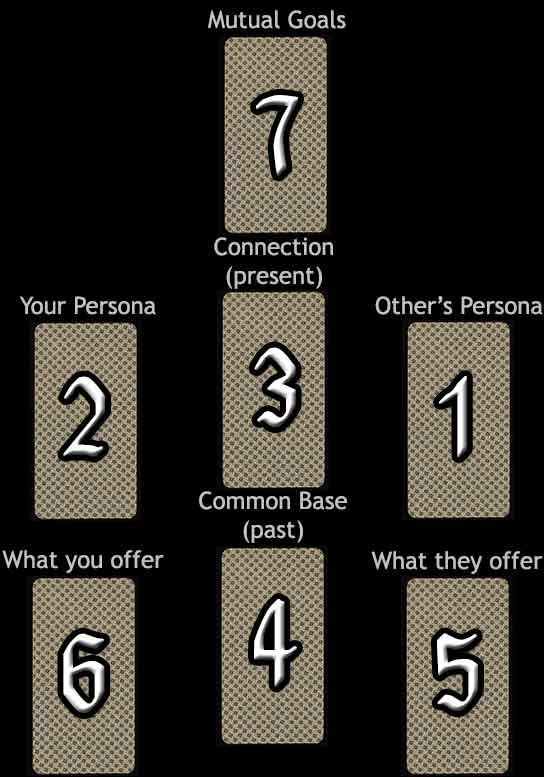
Difficulty: Easy
This relationship spread focuses more on the common ground of the relationship, with three cards in the middle column showing the common ground. The middle column essentially displays the past, present, and future of the relationship.
Card #4 stands for the common base of the relationship, which may be thought of as the past events which have shaped their characters, bringing them together. The current connection that binds them together is Card #3, indicating the values shared. Card #7 implies the common goals that would keep the pair together moving into the future.
The columns on either side show what each partner brings to the table. Remember, relationships need not be romantic, and the partners could even be groups rather than individuals. In this layout, the other person is on the left-hand side and the reader on the right.
Cards #1 & #2 indicate the separate personalities of each member of the relationship. These cards form a sort of bridge with the cards beneath them, #5 & #6, which show the qualities that each partner offers the other person, and thus to the relationship as a whole.
Your Relationship #2 Reading
Mutual Goals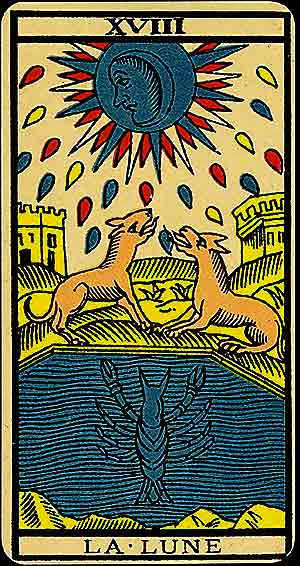 |
||
Your Qualities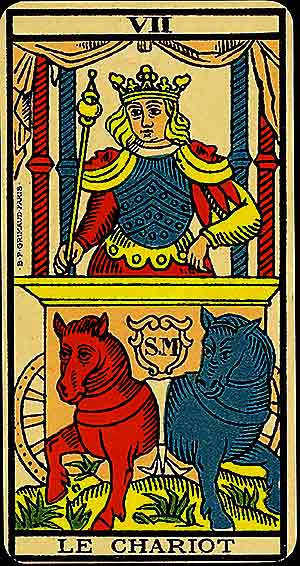 |
Connection (Present)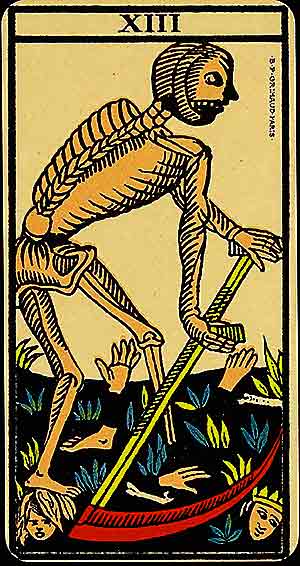 |
Others' Qualities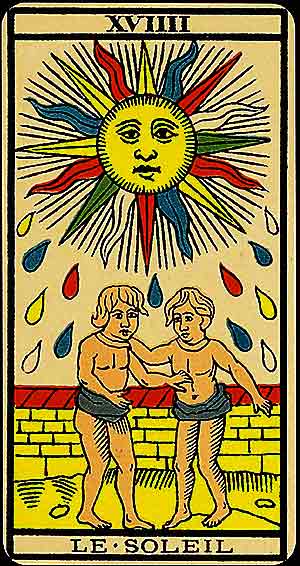 |
What You Bring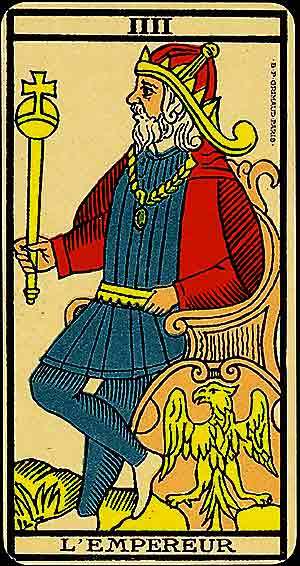 |
Common Base (Past)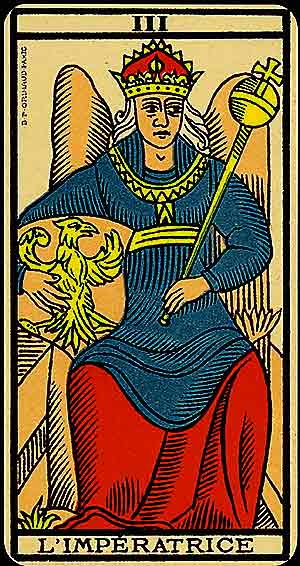 |
What They Bring 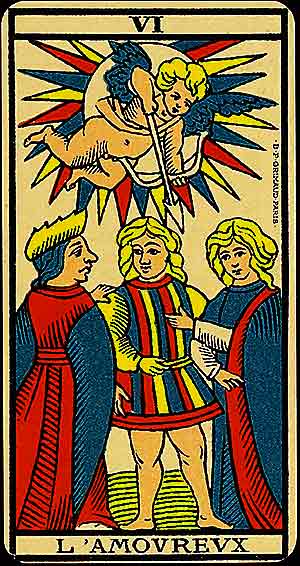 |

7: Mutual Goals
XVIII – The Moon (La Lune)
The Moon symbolises intuition, mystery, and the subconscious. It reflects the realm of dreams, illusions, and emotions, inviting you to explore the depths of your psyche and confront hidden truths.
Symbolism: The Moon casts its dim light over a mysterious scene: a dog and a wolf howl beneath its glow, representing the duality of tame and wild instincts. A crayfish emerges from the water, symbolising the hidden depths of the subconscious rising to the surface. The two towers suggest boundaries between reality and the unknown.
In Relationships: Emotional complexity, hidden dynamics, or the need to trust your intuition. Beware of illusions or misunderstandings.
In Work: A period of uncertainty or unclear direction. It encourages careful reflection and trusting inner instincts over external noise.
Spiritually: The Moon calls for introspection and exploration of the shadow self through dreams, intuition, and subconscious symbols.
When ill-dignified: Confusion, deception, or fear of the unknown. It warns against being lost in illusions or succumbing to anxiety.

3: Connection
XIII – Death (La Mort)
Death signifies transformation, endings, and renewal. While often feared, this card speaks to the cyclical nature of life and the necessity of clearing away the old to make way for the new.
Symbolism: A skeletal figure wields a scythe, cutting through the remnants of the past—hands, heads, and plants alike. The barren ground reflects the stripping away of what no longer serves, while the sprouting flowers hint at rebirth and growth emerging from decay.
In Relationships: The end of a relationship or a transformative phase within one. It signals profound changes, often for the better.
In Work: A major shift, such as the end of a job or the restructuring of goals. It's a call to embrace new opportunities.
Spiritually: Death teaches the power of release and the necessity of embracing life's cycles to achieve transformation.
When ill-dignified: Fear of change, stagnation, or clinging to the past. It warns against resisting the natural process of renewal.

4: Common Base
III – The Empress (L'Impératrice)
This card signifies the creative force in its most abundant and fertile form. It represents growth, nurturing, and the life-giving power of nature.
Symbolism: Her sceptre symbolises authority rooted in creativity and love, while the shield bearing an eagle emphasises vision and protection. The Empress's seated posture on her throne exudes a sensual yet controlled energy, symbolising the harmony between fertility and structure. Her crown and flowing robes represent her connection to divine beauty and earthly abundance.
In Relationships: The blossoming of love or a nurturing, supportive relationship. It is a call to cultivate affection with care and patience.
In Work: A time of prolific creativity and the manifestation of projects. Trust your ability to bring ideas to fruition.
Spiritually: The Empress guides you to honour your divine creative potential, celebrating the interplay between spirit and matter.
When ill-dignified: Overindulgence, stagnation, or excessive control. It warns against smothering growth or being consumed by material concerns.

2: Your Qualities
VII – The Chariot
The Chariot represents triumph through willpower and discipline. It is the card of focused determination, suggesting the mastery of opposing forces to achieve a unified goal.
Symbolism: The charioteer stands tall, guiding two horses of contrasting colours, symbolising duality and control. The canopy above him evokes divine protection, while the wheels in motion reflect progress and momentum. His expression is resolute, embodying control amidst dynamic movement.
In Relationships: Moving forward together, overcoming challenges, or achieving harmony despite differences.
In Work: Success through focus, persistence, and strategic action. Victory is attainable through balance and self-control.
Spiritually: The Chariot teaches the alignment of inner and outer forces, calling for the integration of spirit and will to advance.
When ill-dignified: Lack of direction, recklessness, or internal conflict. It warns against being pulled in opposing directions without clarity of purpose.

1: Their Qualities
XVIIII – The Sun (Le Soleil)
The Sun represents joy, success, and clarity. It is the card of illumination and vitality, promising growth, harmony, and the fulfilment of goals through clarity and connection.
Symbolism: Two children stand joyfully under the radiant Sun, surrounded by a protective wall. The Sun itself symbolises divine energy and enlightenment, while the figures reflect innocence, unity, and shared happiness. The vibrant rays evoke abundance and the thriving life force.
In Relationships: Mutual happiness, harmony, and a joyful connection. Relationships flourish under the light of clarity and love.
In Work: Success and recognition achieved through positivity and effort. It suggests a time of clarity and accomplishment.
Spiritually: The Sun calls for embracing the light within and aligning with your true purpose, radiating joy and love outward.
When ill-dignified: Arrogance, burnout, or overexposure. It warns against taking blessings for granted or letting ego overshadow gratitude.

6: What You Bring
IIII – The Emperor (L'Empereur)

5: What They Bring
VI – The Lovers (L'Amoureux)
The Lovers signifies choice, connection, and the interplay between opposing forces. It represents the power of free will in aligning with one's deepest values and desires.
Symbolism: A central figure stands between two others, often interpreted as a choice between duty and desire or contrasting influences. Above, Cupid aims an arrow, symbolising divine inspiration or the fateful pull of love. The figures' expressions suggest conflict and harmony, reflecting the complexity of relationships.
In Relationships: Profound connections, romantic choices, or a pivotal decision within a partnership. It highlights emotional and spiritual harmony.
In Work: A crossroads where important decisions must align with personal values. Collaboration or partnerships may play a key role.
Spiritually: The Lovers calls for integrating dualities—earthly and divine, passion and reason—on the path to wholeness.
When ill-dignified: Indecision, temptation, or imbalance. It warns of superficial attractions or ignoring inner truth in key decisions.